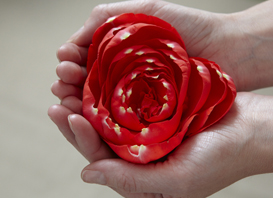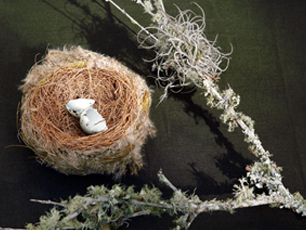- Tweet
-
CALL: (415) 431-3717 Hours: 9AM-5PM PST. EMAIL: WECARE@SEVENPONDS.COM
After Death Planning Guide
2 Choosing Disposition

Choosing Disposition: What Do I Do When Someone Dies?
This section will help you step-by-step through the process of choosing and purchasing disposition, including cremation, natural burial, and burial at sea. Though you may have a preference, we offer some suggestions you might not have considered. Our approach to disposition is contemporary and environmentally sensitive, and therefore we do not discuss traditional burial practices.
While this may be a difficult time for you, it is also important to understand your consumer rights when purchasing disposition. We hope you will find all of the information you need to make the best choice for yourself or someone else, and to provide everyone with peace, comfort, and closure.
Note: The following legal and logistical information is most readily applicable to residents of California. However, where California’s laws or procedures differ greatly from those of the majority of other states, we have made an effort to make our out-of-state readers aware of this.
1. Protecting Your Consumer Rights
Whether you opt for cremation, natural burial, or an alternative disposition choice, it is important to be aware of your consumer rights, and compare potential funeral service providers before making a decision. Although the majority of providers maintain ethical business practices, a history of poor regulation in the U.S. funeral industry has allowed some businesses to implement unfair practices. You might find it helpful to contact nonprofit organizations, such as those listed below, which can guide you through the process and ensure your protection.
The Funeral Rule
The Federal Trade Commission put the Funeral Rule into place expressly to protect you when purchasing goods and services from providers. Under this law:
- A funeral provider has to provide you with a General Price List at the beginning of any discussion of arrangements.
- The General Price List must contain itemized prices of all goods and services offered by the provider. Items cannot be bundled into “packages” without their prices also being listed individually.
- Besides the goods and services you choose to purchase, you are only required to pay a basic services fee to your provider. Other fees and extra items cannot be added to your bill, unless required by state or local law, in which case that law must be provided to you in writing.
- Funeral providers must also quote prices over the phone if you request them. However, the Funeral Rule does not require that providers email, fax, or mail you the price list.
For more information, see our article on The Funeral Rule.
Nonprofit Organizations
There are several organizations that can assist and protect you as you make disposition arrangements:
- The Funeral Consumers Alliance is a nonprofit consumer rights organization headquartered in Burlington, VT, with local affiliate chapters throughout the country. Their mission is to assist you as you work with your service provider, at no charge to you. They are highly accessible by phone or email, and are readily available to offer advice and assistance. For more information see our article SevenPonds Speaks With the Funeral Consumers Alliance.
Funeral Consumers Alliance
(802) 865-8300
- The Green Burial Council is the most reputable natural burial accreditation group in the country. The nonprofit organization certifies businesses, products, and burial sites for their environmental soundness and maintains a national database of certified providers.
Green Burial Council
(888) 966-3330

2. Choosing Cremation
Cremation can be a meaningful and eco-friendly alternative to traditional burial, and is on its way to becoming the most chosen form of disposition in the U.S. There are many ways to personalize a cremation in a way that celebrates your loved one’s life.
While cremation still carries with it environmental concerns such as the burning of fuels and mercury emissions, it generally has much less of an environmental impact than traditional burial. Here, we provide you with the basics of this disposition option. To learn more, read our full article on Choosing Cremation.
Your Cremation Options
You have several options in cremation service providers; however, some service providers only work through a funeral home rather than directly with you. Services, pricing, and who you work with will vary by provider. It may be helpful to tour the facilities before making final arrangements.
Direct cremation is often the most cost-effective option for cremation. With direct cremation, the person who passed is usually transported directly from the place of death to a pre-arranged crematorium, where the cremation occurs without embalming, visitation, or witnessing. This can be a good option if you want to bypass any discussion of a coffin, cemetery, or memorial service.
There are five basic types of cremation providers for you to choose from, all providing direct cremation.
1) Funeral Home
This is the most common provider. The cremation itself, however, is usually contracted out to a crematorium. Funeral homes also offer memorial services, visitation rooms, caskets, and urns.
2) Cremation Retailer
Cremation retailers provide services within a store, and typically offer only direct cremation and cremation urns. They usually provide basic service packages, but as they are not a funeral home their services can be limited. Inquire about additional services in advance with your cremation retailer if these are important to you.
3) Crematorium
Crematoriums can be located within a cemetery or funeral home, or they can be stand-alone facilities. Your area might offer the option to purchase services directly from a crematorium without the liaison of a funeral home. However, not all crematoriums will provide services directly to the public. If witnessing the cremation is important to you, be sure to inquire in advance if this is possible.
4) Funeral Home and Crematorium
There are funeral homes that also have their own crematorium.
5) Funeral Home, Crematorium, and Cemetery
There are service providers that include a funeral home, crematorium, and cemetery all in one location.
See Disposition and Funeral Services on our Local Resources pages to find cremation service providers near you.
Green Cremation Products
There are no laws in the U.S. requiring that a casket be used for cremation. Note, however, that some crematories do require some kind of container, such as a cardboard box. Be sure to inquire what a particular crematorium requires in advance. Choosing natural fiber clothing (without plastic buttons) or plain wooden, woven, or cardboard caskets uses less energy and produces fewer emissions when burned.
If you prefer a casket, look for cremation-specific or biodegradable caskets made from woven wicker, sustainable wood, or organic twined grasses. An inexpensive cardboard casket is a good alternative and can even be decorated by family and friends. Try to avoid plastic, Styrofoam, or fiberglass materials and remove any metal hardware if possible.
You can find many eco-friendly cremation urns and keepsakes online that can be shipped directly to you within a few days. Under natural conditions, biodegradable urns will break down safely. They can even be used to place ashes in water, as they dissolve within a matter of minutes. However, before selecting a biodegradable urn, you should make sure whether they are legal for water scatterings or if an exterior container is required for burial in cemetery grounds.
Visit Cremation and Burial Products in our Local Resources for more information.
Cremation Pricing
Cremation is far more cost-effective than most forms of burial. A standard cremation, including the purchase of an urn, witnessing, and ceremony, can easily cost several thousand dollars; however, direct cremation can be $800 or less. Of course, prices will vary within all of these options, depending on the provider and your location. Compare several providers to make sure that you are paying only for what you are interested in.
Special Considerations: If the person who passed had a pacemaker, it has to be removed prior to cremation for safety reasons. Most cremation providers will do this for a fee.
Documentation
In addition to the death certificate, there may be other forms that you’ll need to file, depending on your state. Many states, including California, require a Disposition Permit, where you can indicate where, when, and how the person who passed will be stored, interred, or cremated. The permit usually has to be returned to the health board within a specified period of days after the death. Your state might also require a Burial Transit Permit and/or a Cremation Permit. For a detailed look at your state’s laws, a good resource is the book Final Rights: Reclaiming the American Way of Death by Joshua Slocum and Lisa Carlson, where you can look up and purchase your state's chapter.
For the most part, your service provider will take care of such documentation. However, if you choose to, you can complete and file the Disposition Permit without assistance. You can contact your local health department for the necessary forms and ask them to walk you through the process.
California has some of the most stringent laws regarding cremation ashes, but all states have various requirements for documentation. Check your state’s laws to avoid missing any necessary documentation.
In addition to a Cremation Permit, California requires a Declaration for Disposition of Cremated Remains, which declares how and where someone’s ashes will be kept or scattered. You will find several options on this form:
- Location of Residence
- Location of Burial
- Location of Scattering
- Location of Scattering at Sea
You and your family might decide to divide the ashes into smaller keepsake urns that several people can individually take with them. If so, note that in California each keepsake urn will need its own Disposition Permit, which accounts for what percentage of the ashes will go to which person and where they will be kept, buried, or scattered. If your family has divided the ashes and one person opts to scatter their portion or bury it in a cemetery, you will have to account for the rest of the ashes that remained in people’s homes. If you are unsure, you can sign off on taking them all home and decide later if you wish to divide and/or scatter the ashes.
Witnessing
There are crematoriums that allow family and friends to stand by to witness as, in a visually sensitive way, the person’s body is placed into the cremation retort. This is a very personal option, and a decision you should make based on your own needs and wishes.
If you choose to witness, this takes about half an hour. Some facilities will also allow you to stay through the entire cremation process, which takes about two hours total. You may find comfort in witnessing a cremation and having the ashes ready for you to take home directly after the process is complete. Inquire about witnessing and what you can expect; only certain crematoriums will allow you to stay until the end. Some crematoriums may also allow you to push the button to start the cremation process. Be sure to inquire as to what to expect regarding the surroundings of the retort; some are standing-room-only industrial areas, while others are posh furnished living rooms with comfortable chairs. You can always request a walkthrough of the crematorium before deciding if witnessing is the right decision.
Meaningful Options for Cremation Ashes
After the actual cremation, you can choose what to do with the ashes, such as having a remembrance ceremony, a scattering, or a burial; or you might want to have the ashes memorialized in an urn or individual keepsakes. We have listed several options below.
Keep them: Keep the ashes near you, encapsulated in a beautiful vessel within your home. Individual keepsake urns or keepsake jewelry are good options if more than one family member wishes to keep the ashes.
Bury the ashes: Bury the ashes in a family plot or on your property, perhaps under an old tree or in a place that has significance. You also have the option of a columbarium, which is an indoor or outdoor space where you can place urned ashes within a wall of niches. Columbariums are usually found in traditional cemeteries, although the design and location can vary.
Scatter them: There are many options available for scatterings: at sea, on land, in a lake, or up in the air (from a plane or weather balloon). You can hire a service or, for a simple scattering, choose to perform it yourself. The scattering of cremation ashes is legal on your own land, but be aware of laws regarding scattering on other privately-owned and public land, as well as in water. Generally, scattering over water is allowed on navigable waterways or 500 yards off the sea shore, but not in lakes and streams. Privately-owned land requires the written consent of the property owner.

3. Choosing Natural Burial
In recent years, there has been a growing movement toward green or natural burial, a form of disposition that has minimal environmental impact due to its simplified service and burial process. With natural burial, the person who passed is placed in a cloth shroud, a cardboard or simple wooden box, or a natural-woven casket and buried without the chemical process of embalming. The Green Burial Council directs specific environmental requirements and certifies many natural burial grounds. For example, there can be no concrete vaults, and the landscape must remain natural without manicured lawns and human-made grave markers. Some natural burial grounds even prohibit simple grave markers like natural rocks and plants, but will instead provide Global Positioning System coordinates.
For more information on natural burial, see our article on Choosing Green Burial.
Locating a Natural Burial Site
This market is still relatively limited, but in most states you should be able to locate a natural burial site within driving distance to you. Natural burial sites vary in things like restrictions and proximity to traditional cemeteries, so inquire as to what to expect. We recommend that you reference the Green Burial Council’s searchable database for an “approved provider” site near you.
Natural Burial on Private Property
You might prefer the much more personal and intimate option of a natural burial on your own property. It is important to understand the local and state requirements to do this legally. In general, it’s easier to arrange private property burials in rural areas. Note that property with a gravesite may be harder to sell, and if it is sold, future generations may not be able to visit the site. We recommend reading the chapter of Joshua Slocum’s book, Final Rights: Reclaiming the American Way of Death, that details your state’s burial and disposition laws. Make sure you research any specific requirements for your area, including zoning requirements, depth below ground, and distance from water sources and habitation.
Documentation
See the beginning of our Documentation section under Choosing Cremation for more information.
Choosing Green Burial Products
You’ll have the option to wrap the person who passed in a beautiful burial shroud or place them in a simple, plain wooden casket. There are a variety of burial shrouds in attractive natural and luxurious fabrics you might want to consider; or, if you prefer a casket, look into biodegradable options. With no federal or state laws requiring you to purchase a casket from a funeral director, you will find many online natural burial product providers that will ship products directly to you. Often natural burial caskets are less expensive and use fewer resources than traditional caskets. See Cremation and Burial Products in our Local Resources for available options.
Natural or Green Burial Pricing
The cost of natural burial generally falls between the cost of cremation and traditional burial, with expenses covering maintenance of the grounds, renovation, restoration, and reseeding. The option of an immediate or direct burial will cost less, somewhere between $1,500 and $2,000, in addition to between $500 to $600 for interment and opening and closing the plot. Additional costs can include documentation, transportation, and graveside services. While these are generally the ranges for prices, they can vary depending on your provider and location.

4. Other Forms of Disposition
Aside from cremation and natural burial, there are some other less common options that you may want to consider. If you’d like more information on any of the options briefly mentioned below, read our article on Other Lesser Used Disposition Options.
Burial at Sea
Many people share a connection to the ocean, and a burial at sea can be a majestic and healing choice. Burial at sea is legal in all coastal states, provided it is performed at least 3 miles from shore and in water at least 600 feet deep. A special shroud or weighted casket designed for sea burial can be used, as the EPA requires that the body sink to the sea floor for final resting. You and your family can choose whether or not you'd like to be present at the burial at sea. Contact a specialized burial at sea provider to help address any questions you may have; check Disposition and Funeral Services on our Local Resources page.
Alkaline Hydrolysis
Alkaline hydrolysis, or “resomation,” is a fairly new practice and is currently only available in a few states. Instead of the retort and heat used in cremation, resomation involves the use of a pressurized stainless steel chamber filled with heated water and an alkaline solution of potassium hydroxide. This process results in a white ash-like material and an eco-friendly liquid that can even be used in the garden. Alkaline hydrolysis potentially uses less energy and produces fewer pollutants than cremation. For more information, read our blog piece on burial and cremation alternatives.
Cryonics
Cryonics is the low-temperature preservation of human bodies for possible future resuscitation. Immediately after death, a person is infused with a substance to prevent ice from forming, and cooled and suspended indefinitely in a container of liquid nitrogen. This technology is not perfected, but many scientists have determined that it will be in time. Cryonics is available through life insurance policies, which usually cost about $100 a month, depending on your age and health. Cryonics has been an option for years, and there are several providers around the country that can place your loved one in cool storage.
Funeral Pyre, or Open-Air Cremation
There are a handful of pyres around the country that cater to specific communities. Most are private, and are accessible to you only through Buddhist monasteries or other organizations. The most well-known of these is in Crestone, Colorado, where the nonprofit Crestone End-of-Life Project (CEOLP) has established a permanent funeral pyre in the sweeping open-air surrounds of the Rocky Mountains. Many who have experienced open-air cremation say that it’s a poignant and spiritual event to witness. Learn more about the Crestone pyre in our interview with CEOLP Director Stephanie Gaines Part One and Part Two.
To see the industry experts whose gracious contributions helped make this guide possible, visit our Acknowledgements.
